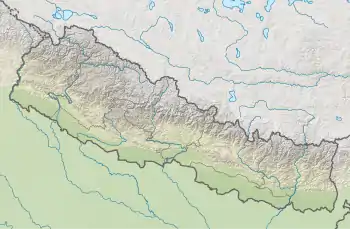| Manaslu Conservation Area | |
|---|---|
| Nepali: मनास्लु संरक्षण क्षेत्र | |
IUCN category VI (protected area with sustainable use of natural resources) | |
 | |
 | |
| Location | Nepal |
| Coordinates | 28°32′46″N 84°50′31″E / 28.546°N 84.842°E |
| Area | 1,663 km2 (642 sq mi) |
| Established | 1998 |
| Governing body | Department of National Parks and Wildlife Conservation |
The Manaslu Conservation Area is a protected area in Nepal. Established in 1998, it covers 1,663 km2 (642 sq mi) in the Mansiri Himal range of the Himalayas in the Gorkha District. The area comprises mountains, glaciers, and watercourses.[1] In elevation, the area ranges from 1,400 to 8,156 m (4,593 to 26,759 ft), the highest point being the peak of Manaslu.[2]
Flora and fauna
The region is home to 33 species of mammals including snow leopard, musk deer and Himalayan tahr. There are over 110 species of birds and three species of reptiles and about 1,500–2,000 species of flowering plants.[1] At least four species of frogs are present: Amolops formosus, Nanorana liebigii, Ombrana sikimensis, and Duttaphrynus himalayanus.[3]
References
- 1 2 Bhuju, U. R.; Shakya, P. R.; Basnet, T. B. & Shrestha, S. (2007). "Makalu Barun National Park". Nepal Biodiversity Resource Book. Protected Areas, Ramsar Sites, and World Heritage Sites. Kathmandu: International Centre for Integrated Mountain Development, Ministry of Environment, Science and Technology, in cooperation with United Nations Environment Programme, Regional Office for Asia and the Pacific. pp. 55–57. ISBN 978-92-9115-033-5.
- ↑ Anup, K. C. & Parajuli, R. B. T. (2014). "Tourism and its impact on livelihood in Manaslu Conservation Area, Nepal" (PDF). Environment, Development and Sustainability. 16 (5): 1053–1063.
- ↑ Shrestha, B. & Gurung, M. B. (2019). "Natural history notes on three sympatric frogs, Amolops formosus (Günther 1875), Nanorana liebigii (Günther 1860), and Ombrana sikimensis (Jerdon 1870), from Manaslu Conservation Area, Nepal" (PDF). Amphibian & Reptile Conservation. 13 (2): 152–159.
External links
- "Manaslu Conservation Area". Department of National Parks and Wildlife Conservation, Nepal. Archived from the original on 2019-09-30. Retrieved 2017-08-21.
This article is issued from Wikipedia. The text is licensed under Creative Commons - Attribution - Sharealike. Additional terms may apply for the media files.